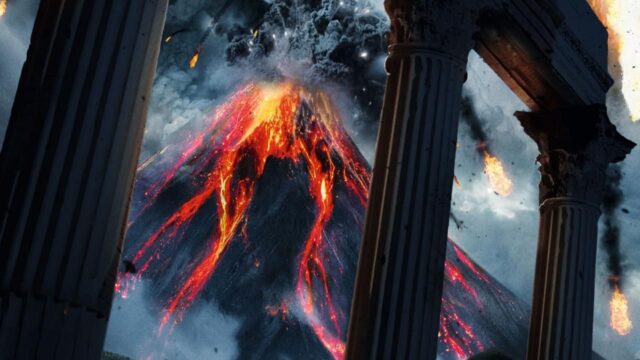In 2014, Paul W.S. Anderson directed a film based on the historic Roman city of Pompeii, frozen in time by the wrath of Mount Vesuvius.
Mount Vesuvius is a dormant volcano that erupted in 79 BC and destroyed the city of Pompeii while perfectly fossilizing its people in ash. Anderson came across these remains during his trip, which profoundly impacted him and instigated him to make a film.
The brainchild of this was 2014’s Pompeii, starring Game of Thrones’ Kit Harrington as Celtic gladiator Milo striving to seek revenge on the Roman General (Kiefer Sutherland) who killed his family.
The film follows a storytelling pattern derived from films like Ridley Scott’s Gladiator and James Cameron’s Titanic, where everything leads to the moment of the volcanic eruption.
The dramatic undertones have coerced many viewers to question whether the film is historically accurate or has Anderson taken ‘creative license’ too seriously.
Fortunately, modern volcanists, National Geographic, and translated letters of Pliny from the Institute of Geophysics give us a first-hand account of what happened and help clear things up.
So, here are four accurate and four inaccurate things about the film Pompeii. Can you guess which is which?
1. The Eruption of Mt. Vesuvius
Verdict: TRUE
Vesuvius doesn’t blast all of a sudden in Pompeii, as it includes tremors and earthquakes that preceded the massive eruption throughout its runtime.
When it finally hits, ginormous pyroclastic waves blanket the streets at a speed of 700km/h, and clouds of debris as high as 20km engulf the skies.
The movie gives a factual account of the blast’s immediate aftermath as people are reduced to charred corpses within moments, and buildings become smithereens after being bashed by massive rocks from the volcano.
2. Balls of Lava Falling on the Streets of Pompeii
Verdict: FALSE
The explosion of Mt. Vesuvius was just one part of the catastrophe, and the events unfolded over an entire day. However, Anderson decided to speed things up and included hot balls of lava shooting from the sky on the streets of Pompeii.
While the visual spectacle was striking, it isn’t factually accurate and is one of the many scenes where the director takes creative liberty to amply what’s already horrific enough.
3. The Different Stages of Eruption: From Earthquakes to Pyroclastic Flows
Verdict: TRUE
Live Science reports that the eruption of Mt. Vesuvius unfolded in phases, and while Pompeii rushes through other elements of the movie, it depicts these phases accurately.
The film portrays the primary blast as well as the pyroclastic surges besides the tremors that preceded the eruption.
These initial surges reached the citizens swiftly but lacked the force to burn them, burying them in a dense layer of ash and rubble instead.
4. The Gigantic Tsunami That Shook Pompeii
Verdict: FALSE
The eruption did alter the nearby landscape and ecology, but it was far from the colossal event that Pompeii portrayed it as. In Anderson’s film, the eruption not only tossed Roman vessels near the harbor but also flung them into the city, with one landing on the main street.
However, there is no proof of such a scenario in the real Pompeii, and the tsunami that followed the blast was relatively mild. Historical accuracy was not in Anderson’s mind while conjuring up this sequence, it seems.
5. Shocked People of Pompeii Fleeing the City
Verdict: TRUE
The sight of the real Pompeii is heartbreaking, as one can witness the frozen moments of its inhabitants. People were caught absolutely unawares and frozen in time. Some were engaged in ordinary chores in their houses, some still slumbering in their beds, and many writhing in pain and terror.
6. Kiefer Sutherland’s Senator Quintas Corvus
Kiefer Sutherland delivers a powerful performance as the wicked Senator Quintas Corvus, who becomes the target of Milo’s vengeance and the obstacle to his love for Cassia.
This character is an invention of the movie, designed to add another human dimension to the conflict, and there is no evidence of a senator or general of his name or description chained to his chariot as he is in the final scene of Pompeii among the remains of the city today.
However, we can find evidence of a Roman senator and military leader, Marcus Aurelius Corvus, who lived about three centuries later.
7. Kit Harrington & Emily Browning’s Characters are Based on ‘The Two Maidens’ Cast
Verdict: TRUE
The sight of the frozen victims in Pompeii is enough to send anyone in a permanent state of shock; mothers holding their babies, children seeking shelter in doorways, and families dying while worshipping their gods. Among the 2000 corpses unearthed, one of the most poignant casts is “The Two Maidens,” showing two people locked in an embrace as the volcanic ash engulfed them. Their love story inspired Milo and Cassia’s fictional romance in Pompeii, a testament to their eternal devotion. Although they were initially assumed to be two women, recent DNA evidence revealed that they were two male lovers.
8. The Gladiators Understand Each Other
Verdict: FALSE
Despite its historical setting, Pompeii fails to deliver a compelling story of gladiators. The film barely explores the lives and struggles of the fighters, who are reduced to mere plot devices for the romance between Milo and Cassia.
Pompeii also ignores the linguistic and cultural diversity of the gladiators, who miraculously understand each other without any barriers. It contradicts the historical evidence that gladiators were often from different regions and had different levels of status and survival.
The film Gladiator, on the other hand, was more faithful to history, at least in some aspects, and offered a more engaging and emotional narrative of the gladiator’s journey.
9. About Pompeii
Pompeii is a 2014 epic romantic historical disaster film produced and directed by Paul W. S. Anderson. An international co-production between the United States, Germany, and Canada, it is inspired by and based on the eruption of Mount Vesuvius in 79 A.D. that destroyed Pompeii, a city of the Roman Empire.
The film stars Kit Harington, Emily Browning, Carrie-Anne Moss, Adewale Akinnuoye-Agbaje, and Jessica Lucas, with Jared Harris and Kiefer Sutherland.
Pompeii premiered in France, Belgium, and Russia on February 19, 2014, and was released over the course of the next day in Argentina, Greece, Hungary, Italy, and later in the United States and Canada on February 21, 2014.














No Comments on The Truth Behind Pompeii Movie: 8 Facts and Myths Revealed